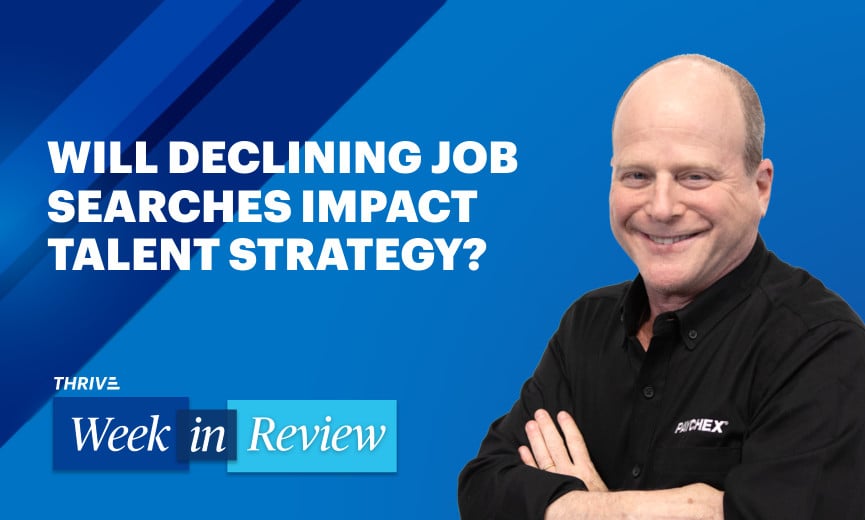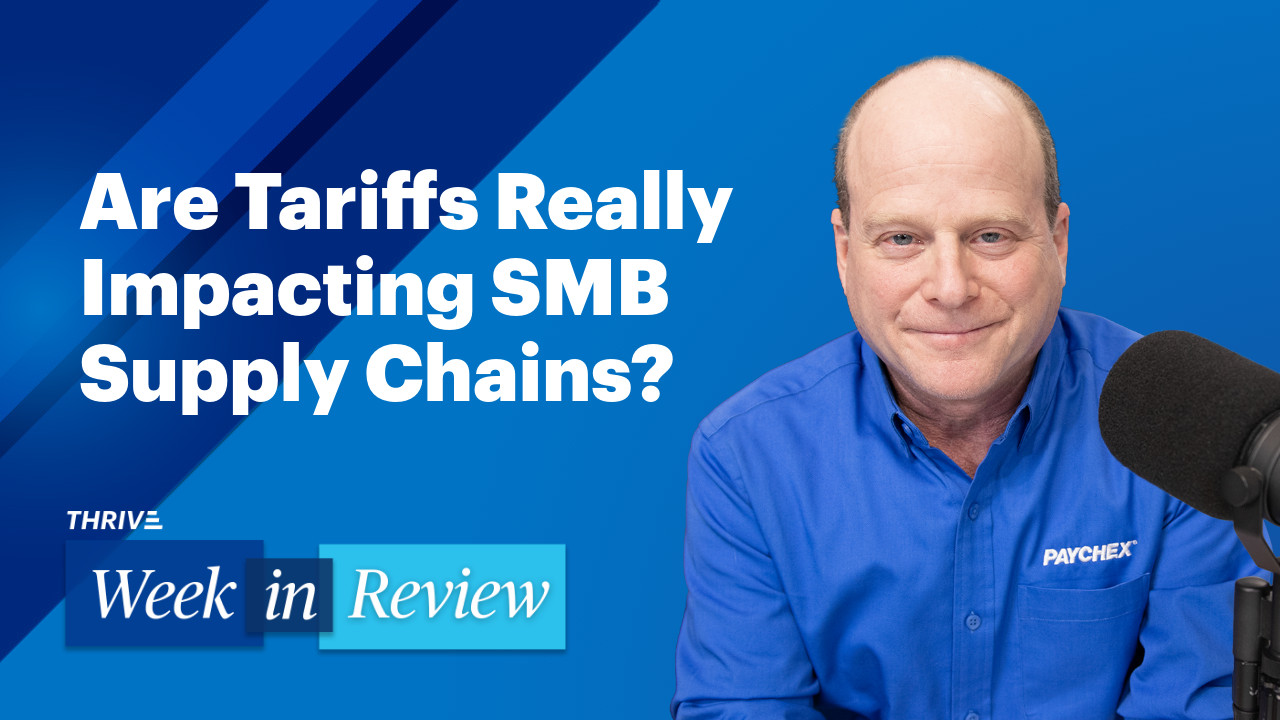- Thrive
-
Temporada
4Episodio94
IA generativa de GoDaddy: potenciando el éxito de su negocio
Podcast •
Vea
Resumen
Escuche al vicepresidente de Producto de GoDaddy, Laka Sriram, mientras habla con el conductor Gene Marks en este episodio de Paychex THRIVE, un podcast empresarial. Conozca lo que tiene para decir sobre la IA generativa, incluido qué es, cómo funciona, qué está haciendo GoDaddy para sus clientes y mucho más.
Los temas incluyen los siguientes:
00:00 – Episode preview
00:38 – Welcome, Laka Sriram
00:56 – An introduction to GoDaddy
02:13 – What is generative AI?
04:03 – AI features for GoDaddy customers
06:22 – Product descriptions with generative AI
09:04 – The importance of a back and forth with AI
10:12 – Solving the writer’s block
11:15 – How chatbots improve
12:37 – The advantage of GoDaddy's tool
13:27 – The state of image generation
17:09 – Intellectual property issues
17:45 – SEO-optimized AI tools
20:19 – Wrap up
Hear more about what’s going on in the world of artificial Intelligence with our podcast episode with Chief Futurist at ARK Investment Management, Brett Winton.
Connect with Laka:
LinkedIn
Ver transcripción
Laka Sriram (00:00):
The biggest thing that it solves is the writer's block that the person have at the beginning. Like instead of staring at a blank screen, like, "Oh my God, "I have all of these things to enter, and where do I start?" And especially if there's not their core competency. They are there to build their business.
Speaker 2 (00:22):
Welcome to "Paychex THRIVE", a Business Podcast, where you'll hear timely insights to help you navigate marketplace dynamics, and propel your business forward. Here's your host, Gene Marks.
Gene Marks (00:37):
Hey everybody, it's Gene Marks, and thanks again for joining us for the "Paychex THRIVE" podcast. Really happy to have you here. My guest today is Laka Sriram. Laka is the VP of Product at GoDaddy. So Laka, first of all, thank you very much for joining. I'm very excited to be speaking with you.
Laka Sriram (00:53):
Thank you, Gene, thank you for having me over here. I'm excited to be here as well.
Gene Marks (00:56):
So, first of all, let's sort of like just set the tone here. Tell us a little bit about GoDaddy. Most people have heard of GoDaddy. I think it's got a really well known brand among small businesses. But explain to us what the company does. And, you are VP of product, so explain to us what that means.
Laka Sriram (01:14):
Yeah, GoDaddy is, the mission of GoDaddy is to help entrepreneurs start, grow, and scale their businesses. And it's to empower entrepreneurs everywhere, is one of our our key motto. And so it's my role over there, I'm a VP of Product at GoDaddy, and I lead generative AI aspects of many things within the company. So, I have been leading, how do we incorporate and adopt all the enhancements and advancements that have happened recently, in the field of generative AI, and embed them into our core products, so that we can be beneficial for our customers, right? Like bridging the gap between all the advancements that have been happening, in those big industry, or the big companies, and bringing them forward and making it easy, and making it available for our customers. I think that's an area that I have been working on, and leading over the past few months at this point.
Gene Marks (02:13):
Perfect, okay. That's great. So yeah, this conversation is about AI, and generative AI. And, generative AI is a term that for those of you guys listening, or watching this, I mean, you know, even me getting my arms around, what that really means for us as business owners, takes a little bit of work to do. But basically, it basically means like ChatGPT, and you know, products like it, you're asking a large language model, a database, questions, and basically it's generating responses back to you in some form. That could be advice or, you know, ways to do things, or examples of doing things. And that's what generative AI is doing for us. And so clearly lucky you guys are making some big investments in that area. So, tell me how that impacts me. You know, like say I'm hosting my website with GoDaddy, here in October of 2023. How do you think that's gonna change what I'm doing, and how you're serving me, over the next year or two, three years?
Laka Sriram (03:17):
Yeah, absolutely. So, but first to your point, generative AI, how you described this was perfect. But it's about, like, it's about generating new content, such as text, images, music, video, and other forms of data, that is like created from existing examples, right? Like the large language model that you described, takes tons and tons of data, and then uses that to train the model, so that it can do a really good job, in predicting that next word, or the next image, that is relevant for the conversation, right? And that ties up to, like, the customers at GoDaddy, like you, and millions of other customers that we have. Fundamentally, the core issue that our customer typically has is, they just want to grow their business. They want establish their business, they want to grow their business, they want to propel their business. They want to make an impact to their customers, right? And aside from technology, functionality, and all that, time is like one of the obvious critical resources that all of these entrepreneurs thrive for. Like, they want to maximize the time that they have, in order to make the biggest impact that they can. And that's where like we at GoDaddy, like we bring the use of generative AI, and embed it into all the different varieties of products that we offer, like to the ones that you already mentioned, right, like starting with websites. Right now, we have features, and tools, that are out there in production, that our customers can automatically generate a large parts of their website, using generative AI features that we have embedded over there. Customers can auto generate product descriptions. And that product description, in fact, was like the first AI-powered feature, like generative AI-powered feature that we launched. This was like back in April of this year. And that is a feature where a customer can upload an image. Like let's say a customer has an online store, right, they can upload an image of their product, and the rest of the page gets filled up based on that, right? And when we launched that, as an experiment, we are very experimentative in our culture at GoDaddy, and we launched it as an experiment, to gather the feedback from our customers, to see if they like it, right? And, the reaction was really, really positive. And we were thrilled to buy the reaction that we saw from the customers. And it was also an organic kind of a promotion, and a reaction that we got from the customers as well. So, besides product descriptions, social posts, social ads, conversations, those are all features that we already have in production, and our customers are making good use of it, as they get to that aspect of their business.
Gene Marks (06:22):
Let me go back to the product descriptions. Can you walk through like how that works in real life? Like, I have a little speaker here, okay, that I'm using. And let's say my company makes this speaker, so it's my proprietary product, and I've made a little mini speaker. It's a Bluetooth speaker, and I wanna sell that, and I wanna put it on my website. I want to use your capabilities to write a product description for this. How does that work? Like do I upload a photo of it? Doesn't it need more information from me to write that product description? How specifically would that work?
Laka Sriram (07:00):
Right. So, in the current state right now, all you have to do is upload that photo of your speaker. And then there is a button that we have, which says like, "auto generate a description for this image," right? And when you click on that one, behind the scenes, we have several steps that happen. The first step is to take that image, and decipher what are all the different objects that are there in that image, what are the different color moods that are there in that image, And so that we can identify the right tone for building the paragraphs. And so, once you identify what is in the image, and the combination of it, then we are able to use that, and send it over to a different model saying, "Hey, here are the keywords that are there in the image, "and this is what we know so far," and generate paragraphs that describe this, in this particular tone, right? So, we are able to provide that, and then get that output, and provide it back to the customer. Now the customer, again, the customer has multiple choices at that point, right? The customer can say, "This is interesting, but I want something more, "I want something different." And they can hit a regenerate button, and this whole process goes through the loop again, and they seek something that is even more enhanced. Or they can say, "Yes, this is great, but I wanna make tweaks to it." Like, there are some aspects to it that are incorrect, right? Because there's only so much of assumptions that we can make from an image, to your point, right? Like, I don't know from a single image, like how big, or elaborate of a business that you're trying to run, with that product. So, you can make edits to it. You can change paragraphs however you see fit, right? You can change particular words as well, and whatever. You can edit it, and then post it. Or you can say, okay.
Gene Marks (09:04):
I'm gonna interrupt just for a second. So, I mean, the way that I see that is that I have this speaker, it's my speaker, you know that I've created, so there's something proprietary about it, or something unique, 'cause it's my product that I'm trying to sell. However, I can upload an image of that to your generative AI tool. It'll recognize that it's a speaker, and it will go forward with writing up a description, based on what it recognizes: the color, you know, the size, based on what it is. And then obviously that description is not gonna be complete, because it's my speaker. There's certain things that you don't know about my speaker, you know, so I have to tell you about that. But I'm telling it to you, through the chatbot, right? So like, I'm, I'm giving you more information about it, and then your AI tool is receiving that information, and then revising the description, based on the information I'm giving. So, it's almost like a back and forth collaborative process, where we're honing the description together, me and the AI robot. Does that make sense?
Laka Sriram (10:06):
Absolutely. And there are fields as well, in the page, where you can enter specific things as well. But to your point, yeah, absolutely. Because the biggest thing that it solves, is the writer's block that the person has at the beginning.
Gene Marks (10:19):
Sí.
Laka Sriram (10:21):
Like instead of staring at a blank screen, like, "Oh my God, I have all of these things to enter, "and where do I start?" Or "Is it good enough?" All those writers' blocks that like general people have, right?
Gene Marks (10:34):
Sí.
Laka Sriram (10:35):
And especially if there's not their core competency. They're there to build their business, and sell speakers, right?
Gene Marks (10:41):
Sí.
Laka Sriram (10:42):
They're not there to actually fine tune English language, in order to best describe what they wanna sell.
Gene Marks (10:50):
But then again, we're the ones that would know best about the speakers, so we have to be part of that collaboration.
Laka Sriram (10:55):
Sí.
Gene Marks (10:56):
And I'm envisioning your chatbot, as being just a very experienced, you know, specialist, in creating product descriptions, as if I have a person right here who does this for a living.
Laka Sriram (11:08):
Mm hmm.
Gene Marks (11:09):
But that chatbot still needs information from me, just like the person would need information from me, right?
Laka Sriram (11:13):
Sí.
Gene Marks (11:14):
And we're going back and forth, and back and forth. And I'm also imagining that as your chatbot gets smarter and smarter, and writes more and more product descriptions, for millions of customers that you have, it just gets that much better, like a human would, at, you know, figuring out what product descriptions make the most sense for a specific type of product. Does that, does that also make sense?
Laka Sriram (11:34):
100%, right? And it's not just product description, it's every area where we are using generative AI, we are using it, or we are providing it, as a tool for the customer, like for the human being, to use to start with, to use it, right? And to work with it, like you described, and then to build that final thing where they say, "Now this looks really good, and it represents me well, "let me publish it," right? So, it's an ongoing, it's a tool, right? It cannot replace, like go in depth, and replace what the customer fully wants, without the customer touching it at all, because there needs to be that human touch, in order to push it out. I think that's the model that we've been, or, that's the model that we've been using for every aspect of every product that we have at GoDaddy. We bring it in front of customers, let them look at it, let them review it. They can do many different things with it, and then they push it out.
Gene Marks (12:37):
And I guess the advantage of using GoDaddy's tool, is that as opposed to say ChatGPT, is that GoDaddy's tool is integrated into my website.
Laka Sriram (12:46):
Mm hm.
Gene Marks (12:47):
So, when I finally finish with the description, I'm like, "Okay, this is cool, I like this description. "Let's post this now, or publish it." Right?
Laka Sriram (12:57):
Mm hmm.
Gene Marks (12:58):
You know, the the point is that you would be able to do that, because I'm on your platform doing this, is that right?
Laka Sriram (13:04):
Yeah, you're on the platform, it's that single space where you can do product description on one side. There are multiple widgets in a website, like there's an "About Us" section and so on. So, all of those things, it just flows from one thing to another. And we are using the same core competencies over there, in order to help the customer build the right things for each widget.
Gene Marks (13:27):
Okay, next question. Images is another thing, and video. I mean there, there's hype around this, and I played with a bunch of AI animators, and AI image makers, and you know, they ain't great yet, you know? I mean, they're pretty awesome when you look at them compared to say, where things were just a few years ago. But, you know, even if you upload, if you ask it to create an image for you, and I played with, you know, DALL-E as well, on Open AI's site, and some other generators, it's, you know, you're like, "Hey create an image of a fox that's burning, on fire, "and walking through Times Square," you know? it creates the image, but it still has a ways to go. And I'm wondering, what are your thoughts on image generation? Like where are we, where are you, at GoDaddy? Where do you see this going?
Laka Sriram (14:18):
Yes, image generation is truly exciting space by itself.
Gene Marks (14:23):
Super exciting, yeah.
Laka Sriram (14:24):
To your point, yes, we are not there yet, from a quality standpoint, or from that same fascination. Like when you look at the output, you get fascinated by how it's generated, and how it resonates with what you're asking for. But you're also left wanting. This is not quite there.
Gene Marks (14:41):
Sí.
Laka Sriram (14:42):
The quality isn't there yet, right?
Gene Marks (14:43):
Sí.
Laka Sriram (14:44):
But there is a lot of acceleration in that space as well. Like the DALL-E 3 got announced, like a couple of weeks ago. I've played around with it, and that looks like definitely multiple steps ahead from its previous version. But it's not available for the public yet, but it's close. And so the possibilities are quite a bit in image, but it's not there. And also, in the past, this happened like at the beginning of this year, right, where there's a certain amount of lawsuits that were filed, about how the image models were being trained, and what images were being used for training, and who owns those images, and whatnot. So, there've been some back and forths in that area, particularly from an image standpoint. But I think these large scale companies that are pushing us forward, by building the core technology, they've also learned through those processes, and through those steps. And I think the more, the ones that are coming out, are more like fine-tuned, from a legal aspect as well. Like they're very careful about how they're training the model. And they're also very clear about who owns what from the images that are produced, or the output images that come from it. So, we are not there yet. It's not like the same full scale as other things. But, it takes, like within GoDaddy, to just tie this all out, back to GoDaddy, and to this conversation that we are having, the Instant Image, or the Instant Video that we launched in Q2 of this year, that again goes through multiple steps, right? Like, so we take that, we take some of the the models that exist externally, and we also build our own models, and we use a combination of those. And we do that in three, four steps, and then produce a auto generated video of it. So we take all of those points that we spoke about earlier, about proprietorship, and legality aspects of it, very seriously. And so that's why we do it in like three, four steps, and then bring it to customers, instead of just doing it in one.
Gene Marks (17:09):
Fair enough. There is a way to go the, you know, the intellectual property issues are a big issue that lot of people are gonna have to face. And I also want to say to you guys at GoDaddy, I mean, you know, and I'm sure you're well aware of this, that, you know, the last thing you want is your customers generating an image, and it happens to be some copyrighted or trademarked image, and they've got it on their site, and they did it using your tool, you know, that that's a problem for everybody.
Laka Sriram (17:36):
Yep.
Gene Marks (17:37):
So, it's good to know that you're aware of that, and that's the kind of stuff that you're, you know, you're working on/ SEO, search engine optimization. So, you know, again, ChatGPT, I'm just using this as an example, 'cause it's just the most popular, you know, so there's clearly there's others, there's other conversational AI chatbots you can use, but, you know, ChatGPT, I mean, I can put in, you know, a website URL, and ask ChatGPT to give me certs engine optimization advice, you know, and SEO you know, thoughts. I'm assuming that happens with GoDaddy. And I guess the real question I have regarding SEO, is, when it starts becoming more AGI-like, when when becomes more artificial general intelligence, more AutoGPT, in other words, instead of giving me advice how to make my website more SEO-friendly, someday, do you expect GoDaddy to get to the point where your AI tools are just going to be, you know, just making your sites as SEO-friendly as possible, like automatically, with the permissions of its users. You're not there yet, but is that something that you can see, as a company moving towards?
Laka Sriram (18:55):
Oh, absolutely, and we are almost there, if not already, in that aspect.
Gene Marks (19:00):
Okay.
Laka Sriram (19:01):
The content that we generate, and provide to the customer, to review, that is SEO-optimized. Like to your points, like in the input prompt. So one of the key aspects of this whole generative AI thing, is the prompt engineering aspect, right?
Gene Marks (191:19):
Right.
Laka Sriram (19:20):
Like, how do we write the correct prompts, to get the maximum benefit from the model, so that it provides the best benefits for the customer? So, our prompts have those keywords, or aspects to it, where the output is SEO-optimized for certain widgets, and for certain content that goes in front of the customer.
Gene Marks (19:49):
That's good to know, that really is. I mean, I'm even thinking where, you know, Google for example, likes to see activity, and current data on a site, not having it be so static. That's why people, you know, they, a few times a week they try to write blogs, you know, to have new contents and information. And I could see GoDaddy's, you know, AI tool, writing those blogs for me, and having them you know, being done, just submitted, so I can just approve the draft before it actually gets published. You've been listening to my conversation with Laka Sriram, the VP of Product at GoDaddy. Thank you very much Laka for joining us. We appreciate your time. Do you have a topic, or a guest, that you would like to hear on "THRIVE?" Please let us know. Visit payx.me/thrivetopics, and send us your ideas or matters of interest. Also, if your business is looking to simplify your HR, payroll, benefits, or insurance services, see how Paychex can help. Visit the resource hub at paychex.com/worx. That's w-o-r-x. Paychex can help manage those complexities while you focus on all the ways you want your business to thrive. I'm your host, Gene Marks, and thanks for joining us. 'Till next time, take care.
Speaker 2 (21:03):
This podcast is property of Paychex, Incorporated. 2023. All rights reserved.

 Apple Podcast
Apple Podcast Spotify
Spotify iHeartRadio
iHeartRadio









